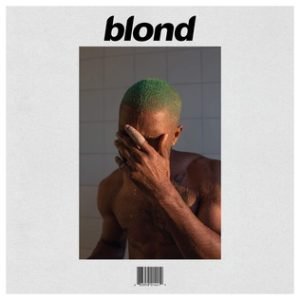When Frank Ocean released Blonde on August 20, 2016, it felt less like an album drop and more like the unveiling of a deeply personal diary, written in metaphors and melodies. Coming four years after his breakthrough debut Channel Orange, Blonde marked a significant departure from the rich, storytelling R&B of its predecessor. Where Channel Orange was lush and expansive, Blonde is sparse, fragmented, and introspective—a soundscape as ethereal as it is intimate.
Contextually, Blonde arrived during a pivotal moment in the music industry, as streaming platforms redefined how audiences consumed music and artists navigated their independence. Ocean’s own path to Blonde mirrored this shift; he famously broke free from his label, Def Jam, by releasing the visual project Endless just a day before Blonde, fulfilling his contract and setting the stage for this truly independent release.
Thematically, Blonde deepens Ocean’s exploration of identity, love, and loss but does so in a more abstract, impressionistic manner. The album sheds the narrative clarity of Channel Orange, instead opting for a sonic and lyrical stream of consciousness. Its meditative quality is deliberate, inviting listeners to linger in the silences, the falsettos, and the emotions that float just beneath the surface.
Sonic Exploration

Blonde is an exercise in sonic minimalism, a masterclass in how less can often be more. The album eschews traditional pop structures and glossy overproduction in favor of a stripped-down, lo-fi aesthetic that feels raw, intimate, and achingly human. This production style mirrors the album’s themes of vulnerability and introspection, immersing the listener in an almost dreamlike atmosphere where every note, pause, and vocal inflection feels deliberate.
Musical Arrangements
The production, spearheaded by Frank Ocean himself alongside collaborators like Om’Mas Keith, Malay, and James Blake, creates a sense of intimacy that feels like a conversation whispered late at night. Tracks like “Self Control” and “White Ferrari” are built around soft, undulating guitar lines that give the songs a tender, fragile quality. On “Ivy,” distorted guitar tones provide a haunting backdrop, evoking both nostalgia and heartbreak. These choices make the listener feel as though they are experiencing Ocean’s emotions in real-time, unfiltered and raw.
Vocally, Blonde is a revelation. Ocean’s voice moves fluidly between registers, often employing falsetto and pitch manipulation to create an ethereal, otherworldly quality. On “Nikes,” the opening track, his vocals are drenched in pitched-up effects, immediately signaling the experimental nature of the album. In contrast, songs like “Godspeed” rely on his unadorned voice, soaring over sparse instrumentation to devastating effect. The interplay between these vocal styles keeps the album dynamic while reinforcing its emotional depth.
Instrumentally, Blonde is sparse but not barren. The arrangements are often built around a single instrument—be it a piano on “Solo,” the swirling synthesizers of “Seigfried,” or the acoustic guitars that dominate much of the record. This minimalism serves to foreground Ocean’s voice and lyrics, ensuring that nothing distracts from the raw emotion at the album’s core. Notably absent are the heavy drum patterns that define much of contemporary R&B and hip-hop, a choice that leaves the songs feeling airy and unbound by genre conventions.
Genre Elements
Speaking of genre, Blonde defies easy categorization. While rooted in R&B, the album draws heavily from indie rock, ambient, and even classical music. The gospel-tinged harmonies of “Godspeed,” the baroque pop sensibility of “White Ferrari,” and the experimental, beatless structure of “Seigfried” illustrate Ocean’s ability to blend genres in ways that feel entirely his own. This fluidity not only challenges genre boundaries but also mirrors the album’s broader themes of identity and transformation.
Lyrical Analysis

At its core, Blonde is a lyrical exploration of identity, love, memory, and the passage of time. Frank Ocean’s lyrics delve into deeply personal territory, touching on themes of heartbreak, self-discovery, and the fluidity of relationships. The album often feels like a mosaic of fleeting memories and emotions, pieced together with poetic fragments that evoke a sense of longing and introspection.
Recurring Themes
Recurring motifs play a significant role in anchoring Blonde’s themes. The concept of duality—blonde vs. blond, masculine vs. feminine, past vs. present—runs throughout the album, reflecting Ocean’s exploration of his own identity and the complexities of human connection. On “Ivy,” he revisits a youthful love that has soured over time, with lines like “I thought that I was dreaming when you said you loved me” encapsulating both the euphoria and the pain of nostalgia. Similarly, “Seigfried” meditates on themes of existential doubt and self-acceptance, its lyrics juxtaposing grand philosophical questions with intimate personal revelations.
The lyrical depth of Blonde lies in its abstract, impressionistic style. Unlike the linear storytelling of Channel Orange, this album’s lyrics are fragmented and open-ended, often leaving the listener to fill in the gaps. On “Nights,” Ocean captures the disorienting shifts between joy and despair with a nonlinear narrative that spans breakups, financial struggles, and self-reflection. The track’s midpoint, marked by a striking beat switch, symbolizes a turning point in both the song’s narrative and its emotional arc.
Frank Ocean’s use of metaphor and imagery further enhances the album’s poetic quality. On “White Ferrari,” he paints a picture of fleeting intimacy with lines like “I’m sure we’re taller in another dimension”, blending surreal imagery with the grounded reality of a relationship’s impermanence. Meanwhile, “Solo” weaves together religious symbolism and solitude, with its refrain of “In hell, there’s heaven” encapsulating the bittersweet duality of independence.
Emotional Impact
Emotionally, the lyrics of Blonde are devastatingly effective. They carry a vulnerability that invites listeners to connect with Ocean’s experiences while reflecting on their own. Tracks like “Self Control” and “Godspeed” tug at the heartstrings with their raw depictions of unrequited love and bittersweet farewells. Yet, the album also leaves room for moments of quiet contemplation, as on “Seigfried,” where Ocean’s musings about solitude and self-doubt resonate deeply with anyone who has ever questioned their place in the world.
Cohesion and Flow

Blonde is a masterclass in crafting an album that feels both deeply cohesive and intentionally fragmented. The track progression mirrors the emotional and thematic ebb and flow of memory itself, where moments blend, overlap, and sometimes diverge unexpectedly. While the album eschews a straightforward narrative structure, its sequencing creates a mood-driven journey that feels organic and immersive.
From the shimmering, dreamlike opening of “Nikes” to the tender farewell of “Futura Free,” Blonde feels like a single, unbroken thread of thought, even as it shifts between sonic textures and emotional tones. Tracks transition seamlessly, often bleeding into one another or relying on ambient interludes that give the listener space to process what they’ve just heard. The stark beat switch in “Nights” is a standout moment that punctuates the album’s central pivot, both musically and thematically, while maintaining a logical flow that ties the two halves of the song—and the album as a whole—together.
Thematic Consistency
Thematic consistency is one of Blonde’s greatest strengths. Every track feels like a piece of a larger puzzle, exploring facets of love, identity, and introspection through different lenses. Whether it’s the melancholy reflection of “Ivy,” the spiritual yearning of “Godspeed,” or the bittersweet self-awareness of “Solo,” each song contributes to a broader exploration of vulnerability and self-discovery. Despite its eclectic influences and unconventional structures, the album never feels disjointed; its themes and emotions act as a connective tissue, holding everything together.
Even the interludes, like “Be Yourself” and “Facebook Story,” play a role in reinforcing Blonde’s overarching themes. While they might initially feel like interruptions, they ultimately serve as meditative pauses that deepen the album’s exploration of identity, modern relationships, and societal expectations. These moments create a sense of rhythm within the album, allowing for a natural progression of emotions that mirrors the cycles of joy, pain, and reflection.
Stylistically, Blonde is remarkably cohesive despite its genre-blurring tendencies. The consistent use of sparse arrangements and Ocean’s emotive vocal delivery ties together the album’s eclectic influences, from the acoustic tenderness of “White Ferrari” to the ambient experimentation of “Seigfried.” The result is a work that feels unified in its sonic and thematic identity, even as it defies conventional expectations of genre or structure.
Standout Tracks and Moments
Blonde is an album full of highlights, but certain tracks and moments rise above the rest, encapsulating Frank Ocean’s brilliance and the album’s emotional and artistic depth. These standout elements not only define the project but also leave an indelible mark on the listener.
Key Tracks
“Nikes”
As the album opener, “Nikes” immediately establishes the dreamlike and experimental tone of Blonde. The track begins with Ocean’s voice distorted into a high-pitched falsetto, giving the song an otherworldly feel. Lyrically, it’s a meditation on materialism, fame, and love, blending vivid imagery with poignant vulnerability. The moment his natural voice emerges midway through is striking, grounding the song in raw emotion.
“Ivy”
A sonic and emotional centerpiece, “Ivy” explores the heartbreak of lost love with stark intimacy. The stripped-back arrangement—anchored by jangling, slightly distorted guitar chords—creates a haunting atmosphere, while Ocean’s vocal delivery conveys both nostalgia and regret. The repeated line, “It’s quite alright to hate me now”, captures the bittersweet essence of the song, making it one of the album’s most memorable moments.
“Nights”
Widely regarded as one of Blonde’s defining tracks, “Nights” showcases Ocean’s ability to blend storytelling with experimentation. Its shifting structure, marked by the iconic beat switch halfway through, mirrors the transitions in the song’s narrative—from romantic highs to existential lows. The second half, with its hypnotic guitar loop and Ocean’s meditative lyrics, embodies the album’s introspective and dreamlike quality.
“Self Control”
This track is a heart-wrenching ode to unrequited love and the complexities of letting go. Ocean’s layered vocal harmonies in the chorus, coupled with the sparse instrumentation, evoke a sense of yearning that’s both universal and deeply personal. The plaintive plea of “Keep a place for me” lingers long after the song ends, making it one of the album’s most emotionally impactful moments.
“Godspeed”
A spiritual farewell, “Godspeed” closes the emotional arc of the album with grace and tenderness. Ocean’s vocals, paired with gospel-inspired harmonies and sparse piano accompaniment, feel like a benediction. The song’s message of unconditional love and forgiveness is both powerful and comforting, offering a sense of closure without finality.
Memorable Moments
The Beat Switch in “Nights”
The transition in “Nights” is one of the most celebrated moments in Blonde. The shift from the upbeat, rhythm-driven first half to the slower, atmospheric second half is both jarring and seamless, marking a turning point in the album’s mood and narrative. It’s a perfect encapsulation of the album’s duality and Ocean’s ability to surprise and captivate.
The Spoken Interludes
Tracks like “Be Yourself” and “Facebook Story” might seem like outliers, but they serve as reflective pauses that deepen the album’s themes. The former features a voicemail from a mother urging her child to avoid drugs and alcohol, while the latter tells a story of digital-age relationship disconnection. These interludes provide context and texture, grounding the album’s introspection in everyday realities.
The Closing Lines of “Futura Free”
The final track, “Futura Free,” ends with a recording of a casual conversation among friends, fading into the sounds of waves. This moment feels like an invitation to reflect, tying back to the album’s themes of memory and impermanence. It’s an understated yet profound conclusion to an album that’s as much about what is left unsaid as what is spoken.
Ocean’s Falsetto in “White Ferrari”
The delicate, almost ethereal falsetto on “White Ferrari” captures a sense of fleeting beauty and nostalgia. Coupled with sparse instrumentation, this moment exemplifies Ocean’s mastery of restraint, allowing emotion to take center stage.
Artistic Contribution and Innovation

Blonde occupies a rarefied space in music history, transcending its categorization as an R&B album to become a landmark in modern music. Upon its release, it not only redefined Frank Ocean’s artistic identity but also pushed the boundaries of what an album in the digital era could be—a deeply personal and genre-defying work that prioritizes emotion and experimentation over commercial appeal.
Place in Genre and Industry
Within the R&B landscape, Blonde shattered expectations. At a time when contemporary R&B often leaned on radio-friendly hooks, booming 808s, and heavily produced soundscapes, Ocean offered a work of quiet introspection and minimalism. His decision to strip away traditional beats, lean into unconventional song structures, and let silence and space play a pivotal role challenged the genre’s norms. This approach invited comparisons to experimental artists across genres, signaling a shift in how R&B could be conceptualized—not as a static category but as a fluid, evolving art form.
In the broader music industry, Blonde was revolutionary for its release strategy. By dropping the visual album Endless the day before Blonde—fulfilling his contractual obligations with Def Jam—Ocean asserted his independence as an artist. The subsequent release of Blonde on his own label, Boys Don’t Cry, was a bold statement of creative and financial autonomy. This move has since inspired other artists to rethink traditional industry models, paving the way for a new era of independence and self-determination in music.
Innovation
Production as a Narrative Tool
The sparse, often ambient production of Blonde is a striking departure from Ocean’s earlier work and much of the R&B landscape. Instead of layering tracks with heavy instrumentation, the album employs negative space as a narrative device. The moments of silence or sparse instrumentation—such as the stark guitar line on “Ivy” or the subdued piano chords on “Godspeed”—allow the listener to focus on the emotional weight of the lyrics and Ocean’s voice. This deliberate restraint was innovative in its ability to amplify emotional intimacy.
Genre Fluidity
Blonde blurs the lines between genres in ways that feel entirely fresh. While its foundation is rooted in R&B, the album draws from indie rock (“White Ferrari”), ambient music (“Seigfried”), and gospel (“Godspeed”). This genre-fluid approach not only expands the boundaries of R&B but also positions Ocean as a pioneer of a new era of hybrid, undefinable music. The result is an album that resists easy classification, inviting listeners to experience it on its own terms.
Lyrical and Thematic Innovation
Ocean’s abstract, poetic lyricism in Blonde is another key area of innovation. By moving away from the narrative storytelling of Channel Orange in favor of fragmented, impressionistic vignettes, Ocean created a listening experience that feels more like reading a collection of poems than hearing a set of songs. The album’s recurring themes—identity, memory, love, and loss—are explored in ways that are deeply personal yet universal, giving the work an emotional resonance that feels timeless.
Emphasis on Emotional Authenticity
Blonde was groundbreaking in its prioritization of emotional authenticity over commercial considerations. Tracks like “Self Control” and “Seigfried” forego traditional structures and hooks, instead unfolding as raw, introspective monologues. This willingness to embrace vulnerability and imperfection stands in stark contrast to the polished sheen of much of mainstream music, marking Ocean as a uniquely authentic voice in the industry.
Cultural Impact
The album’s influence extends beyond music, impacting fashion, art, and LGBTQ+ representation in the industry. Ocean’s openness about his sexuality, paired with the universal themes of Blonde, challenged societal norms and inspired a wave of artists to embrace their identities more freely. The cultural ripple effects of Blonde—from its DIY ethos to its meditative exploration of selfhood—continue to resonate.
Closing Thoughts

Blonde is a landmark album that transcends the boundaries of genre and traditional music-making. It is a work of quiet revolution, defying the conventions of R&B with its sparse production, abstract lyricism, and deeply personal exploration of identity, love, and memory. Frank Ocean’s willingness to embrace vulnerability and imperfection results in a body of work that feels intimate yet universal, experimental yet timeless.
Strengths
The album’s greatest strength lies in its emotional authenticity. Every track, from the meditative “Seigfried” to the heart-wrenching “Self Control,” feels like an unfiltered window into Ocean’s soul. The production is another standout feature, using minimalism and negative space to amplify the emotional weight of the songs. The seamless blending of genres adds yet another layer of innovation, positioning Blonde as a boundary-pushing masterpiece.
Weaknesses
For some listeners, the abstract and fragmented nature of the album might feel inaccessible. Its lack of traditional hooks and beats, coupled with its introspective themes, may not resonate with those seeking immediate gratification. However, these qualities are not so much flaws as they are intentional choices that align with the album’s vision.
In the context of Frank Ocean’s career, Blonde is a definitive statement of artistic freedom and innovation. It represents a bold departure from the more structured storytelling of Channel Orange, signaling Ocean’s evolution as a creator unafraid to take risks. For listeners, Blonde offers an emotional experience that is as much about self-reflection as it is about Ocean’s world. It’s an album that doesn’t demand to be understood in a single listen but rather invites repeated engagement, revealing new layers with every revisit.
Official Rating
Blonde earns a perfect 10 not because it conforms to traditional ideas of perfection but because it redefines what perfection can mean in music. It’s an album that challenges, comforts, and inspires in equal measure, offering an experience that feels both deeply personal and profoundly universal. Its willingness to prioritize artistry over accessibility, vulnerability over gloss, and experimentation over convention makes it not just an album but a cultural milestone.
